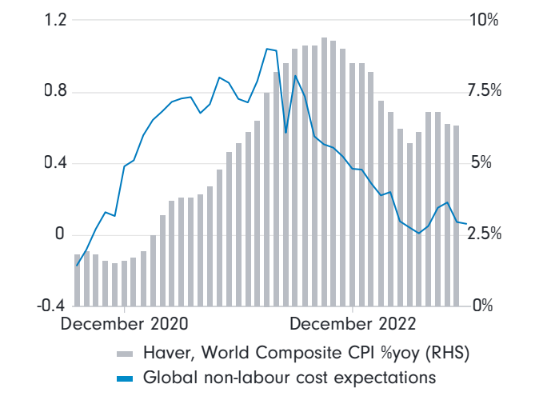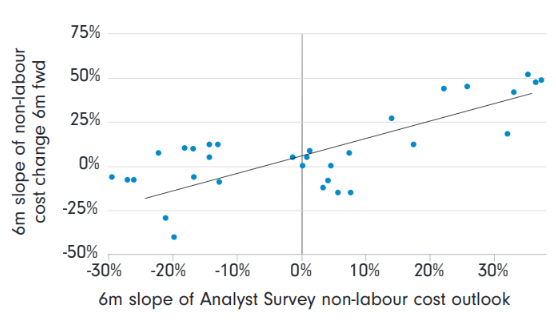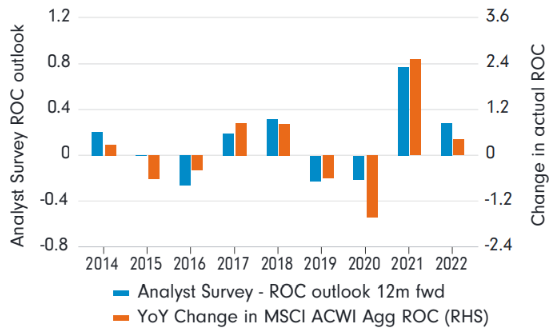Fidelity analysts have more than 20,000 company meetings every year. Put another way, on any working day one of our analysts is speaking to a company’s management every 10 minutes.
These aren’t all Zoom calls, either. In the past year our analysts have gone to the deserts of Inner Mongolia, to the jungles of Borneo, to factories in Bangladesh, to countless boardrooms and conference halls and works sites, always seeking answers to the big question that never goes away: “What’s happening?”
Because, as you may have found yourself, getting your boots (and if need be, your passport) dirty is often the only way to know what’s really going on.
A decade of spotting trends early
The Analyst Survey is one way we draw on all that accumulated knowledge. Every December we ask our analysts around 80 questions that probe their knowledge of the companies and sectors they cover. Taken together, the responses paint a vivid picture of how different regions and sectors will fare in the year ahead - and beyond.
But that’s only the start. We follow up on the most compelling responses, teasing out nuances and understanding context. We can do this to our heart’s content because everyone who answers the survey works here. We don’t have to take raw survey results at face value. We keep drilling.
Our goal is to bring you a report you can easily digest, remember, and use as a guide. And Analyst Survey reports have often proved prescient. A decade ago, the 2014 survey correctly predicted that knowledge economy sectors like technology and pharmaceuticals would fare much better than sectors like energy and materials. The survey also warned about the wave of defaults among resource names in the high-yield bond market that arrived the following year. Over the past 10 years it has also called booms in M&A, share buybacks, and dividend pay-outs.
More recently, at the onset of the pandemic we began running shorter monthly and quarterly surveys to complement the annual. These include questions about companies’ cost pressures. Fidelity analysts have shown a consistently strong understanding of how raw materials and other input costs are affecting their sectors; as well as when and how that is likely to change. Indeed, at a time when much of the inflation debate was focused on labour market dynamics, our analysts’ responses about companies’ non-labour costs proved to be a consistent early signal on inflation.
An early warning of post-Covid inflation

Chart shows World Composite CPI inflation against the weighted average of Analyst Survey responses to the question ‘What are your expectations for total non-labour costs at your companies over the next 6 months compared with current levels?’ The responses ‘significant increase’ and ‘significant decrease’ receive a double weighting. Sources: Fidelity International Analyst Survey, Haver Analytics.
Digging deeper, regression analysis shows a good relationship between the 6-month trend in analysts’ responses to this question and the 6-month forward trend in changes to companies’ non-labour costs. In other words, whenever our analysts grow more concerned about rising costs, the evidence shows it has tended to precede a period of rising cost inflation. And vice versa.
Seeing cost rises (and falls) before they come

Chart shows the gradients of the line of best fit for 6 consecutive months of weighted averages of Analyst Survey responses to the question ‘What are your expectations for total non-labour costs at your companies over the next 6 months compared with current levels?’ for the period July 2020 to July 2023, plotted against the gradients of the line of best fit for actual reported changes in companies’ non-labour costs over the subsequent 6-months for the period December 2020 to December 2023. Sources: Fidelity International Analyst Survey, MSCI ACWI Aggregates.
This makes sense, of course. Our analysts study their companies’ supply chains, talk to their suppliers, obsess over industry minutiae, compare notes with other Fidelity analysts in the same and adjacent sectors, and, of course, have all those management meetings. It’s their job to know what’s happening with their companies’ costs. And they do it well.
Cross-asset collaboration
Fidelity analysts are responsible for making individual security recommendations, which portfolio managers can then use to inform investment decisions for client funds. Our analysts talk to both listed and non-listed companies, and the global research team covers equities, fixed income, and private credit. That means that any analyst, covering any asset class, in any part of the world can talk to a colleague in one of our offices around the world and benefit from their expertise. They can then build up a detailed picture of a company’s fundamentals.
And over the years, analysts’ responses to survey questions have given valuable clues as to how those company fundamentals were about to change. Take the question about returns on capital in the next 12 months, which we have asked every year since 2014. We can compare analysts’ responses to companies’ actual reported ROC, proxied by MSCI ACWI aggregates, as of 31 December of every year up to 2022 (the 2023 numbers for comparison won’t be available from company reports for another few weeks yet).
That gives us nine years in total. Averaged together, our analysts’ responses at the start of the year have correctly predicted the direction of ROC by the end of it in eight of those nine years.
Will ROC go up or down next year? And did it?

Chart shows weighted average of responses to the question ‘What is the outlook for overall returns on capital for your companies for the next 12 months?’ plotted against the year-on-year change in actual reported returns on capital as of 31 December of that year. NB 2022 is the most recent year for which actual reported ROC data are currently available. Sources: Fidelity International Analyst Survey, MSCI ACWI Aggregates.
It’s a small sample size, but it shows the value of blocking out the noise and zeroing in on what matters most: the fundamentals.
Giving you the knowledge that top-down research misses
It is this focus on the nuts and bolts of individual companies that gives the Analyst Survey its power. This is not your usual 30,000 feet overview of economic conditions drawn from public data and official indicators. Our Analyst Survey is built from the ground up, drawing entirely on the knowledge of in-house experts.
We use the survey findings to inform our internal discussions, such as those at our Cross Asset Investment Forum, where we find the survey output often provides a healthy challenge to our other research, and at other times a confirmatory signal from a different perspective.
We hope you too will find the survey a useful companion to your own research.
